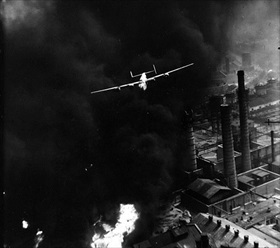BOMBERS BLAST VIENNA OIL REFINERIES
Foggia Airfield Complex, Southeast Italy · June 16, 1944
On this date in 1944 nearly 600 B‑17 Flying Fortresses and B‑24 Liberators from the U.S. Fifteenth Air Force took off from bases in Foggia, Southeastern Italy, to attack oil refineries around Vienna, Austria, and Bratislava, Czechoslovakia. After Romania, Austria was the biggest Axis crude oil producer, sending half its crude to local oil refineries and the other half to refineries in neighboring Czechoslovakia and Hungary. Austria’s oil refinery at Floridsdorf, on the northern edge of Vienna, had been targeted almost three months earlier, when U.S. heavy bombers carried out their first attack on Austrian soil. On this date B‑17s targeted the Floridsdorf and nearby Kagran oil refineries, while B‑24s struck oil refineries at Lobau, west of Vienna, Schwechat, southeast of Vienna, and the Apollo oil refinery at Bratislava. Ten days later and again in August bombers revisited Floridsdorf, Lobau, and Schwechat.
Elsewhere in Germany and the occupied territories, the Fifteenth and Eighth Air Forces hammered Axis petroleum facilities so badly that Nazi Armaments Minister Albert Speer told Adolf Hitler in the summer of 1944 that Germany’s aviation gasoline production had been severely compromised in May and June. If Germany could not protect its refineries and hydrogenation factories by all available means, it would be impossible to get them back into working order from the state they were in. He predicted if it came to that, “by September we shall no longer be capable of covering the Wehrmacht’s most urgent needs.”
Speer’s lamentations would have been music to the ears of Gen. Carl Spaatz, head of U.S. strategic air forces in Europe, had he heard them. On D-Day, June 6, 1944, Spaatz said that the primary aim of the Eighth and Fifteenth Air Forces was to deny oil to the enemy. Between September, the critical month Speer had mentioned in his talk with Hitler, and January 1945, oil targets, including oil storage depots and plants producing synthetic oil from coal, became the air force’s highest priority. Writing in 1970, Speer said that the Allied oil campaign “meant the end of German armaments production.” Luftwaffe general and flying ace Adolf Galland reminisced that the Allied oil campaign was “the most important of the combined factors which brought about the collapse of Germany.”
Operation Tidal Wave: Attacking Romania’s Ploiești (Ploesti) Oil Complex, August 1, 1943
 |  |
Left: In 1943, crude and refined oil from Romania’s Ploiești (Ploesti) oil fields provided about 35 percent of all Axis oil supplies, five times what runner-up Austria provided. Strategic planners concluded that the destruction of the Axis oil industry held the key to the Luftwaffe’s defeat, and that of Germany as well. In this photo oil storage tanks at the Columbia Aquila refinery, one of eleven in the Ploiești refinery complex, burn after the raid by Libyan-based B‑24 bombers of the U.S. Ninth Air Force, assisted by Liberators from the Eighth Air Force based in England.
![]()
Right: B-24 Liberators approached Ploiești’s oil refineries at low altitude to avoid detection by German radar. This iconic image, one of the most famous of World War II, shows The Sandman, piloted by Robert Sternfels, as it emerges from a pall of smoke, barely clearing the stacks of Astra Romana refinery, the largest of Ploiești’s refineries.
 |  |
Left: Liberators flew into the mouth of Ploiești’s defenses, which included several hundred 88mm (3.46‑in) and 105mm (4.1‑in) antiaircraft guns. Many more small-caliber guns were concealed in haystacks, railroad cars, and mock buildings. In addition the Luftwaffe had three fighter groups within flight range of Ploiești, assisted by some Romanian fighter aircraft.
![]()
Right: Despite months of planning, preparation, training, and practice, the August 1, 1943, mission over Ploiești was one of the costliest for the USAAF in the European Theater: 53 aircraft and 660 out of 2,000 airmen were lost. Only 88 B‑24s of the original 178 aircraft returned to Libya. Some landed in neutral Turkey, where the airmen were interned, and some landed at an RAF airfield on Cyprus. August 1 was later referred to as “Black Sunday.” Sadly for the Allies, within weeks most of the damage to the refineries had been repaired, and the net output of fuel was greater than before the raid.
1943 Newsreel Includes Scenes from Ploiești, Churchill’s Visit to North America, Building Liberty Ships, Navy Men on Leave, and Patton in Sicily
![]()

 History buffs, there is good news! The Daily Chronicles of World War II is now available as an ebook for $4.99 on Amazon.com. Containing a year’s worth of dated entries from this website, the ebook brings the story of this tumultuous era to life in a compelling, authoritative, and succinct manner. Featuring inventive navigation aids, the ebook enables readers to instantly move forward or backward by month and date to different dated entries. Simple and elegant! Click
History buffs, there is good news! The Daily Chronicles of World War II is now available as an ebook for $4.99 on Amazon.com. Containing a year’s worth of dated entries from this website, the ebook brings the story of this tumultuous era to life in a compelling, authoritative, and succinct manner. Featuring inventive navigation aids, the ebook enables readers to instantly move forward or backward by month and date to different dated entries. Simple and elegant! Click 











